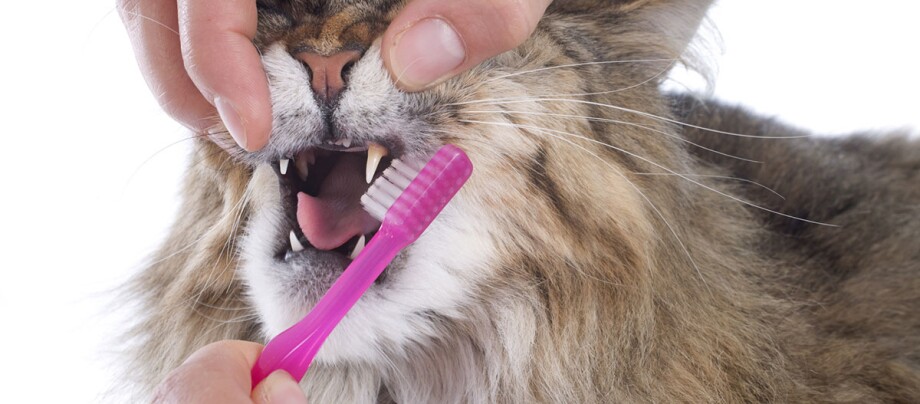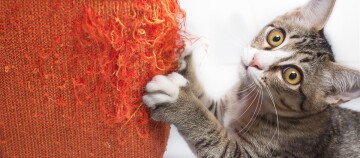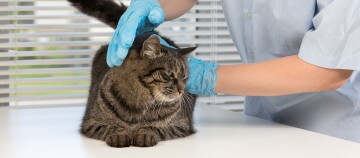Cleaning a Cat's Teeth Isn't Easy - Proper Dental Care Is Important
14.11.2022 - Reading time: 5 minutes

You have no doubt had the opportunity to have a look at your feline friend’s teeth. Even in a relaxed yawn, the sharp fangs remind us that it is a predator who is cuddled up on the sofa. Healthy teeth is fundamental to the survival of the cat, even it no longer has to catch its own prey thanks to its human carer. On the other hand, the state of the teeth can provide clues to the health of the cat. In any case: Anyone who wants a strong bite has to take care of their teeth. A human companion can help here.
How is a cat’s jaw shaped?
First, let’s take a look inside a cat’s mouth. A house cat’s jaw contains thirty teeth: it each side of each jaw there are three incisors, one canine, two (below) or three (above) front molars and one rear molar. These rear molars only appear during teething. Kittens have 26 baby teeth which are replaced by adult teeth between the ages of three and six months. The canines together form the fangs that are typical for predators: thanks to space between them in the bite, these teeth can move past one another. The animal uses the fangs to grab and kill prey. The molars, which have developed into incisors, the cat tears away meat and swallows portions whole without chewing.
How do I recognize a gum infection in my cat?
A shockingly high number of cats have problems with their jaws: around three quarters of cats suffer from impairments in their mouth. Tartar often is a warning sign, which is formed in the same way as in people: food residue solidifies on the teeth and forms plaque, which hardens into tartar due to the minerals in the saliva, causing gum infections and paradontosis. The teeth become loose and there is a risk of a loss of teeth and the functionality of the bite.
In other, rarer, cases, the gums may also be attacked by immune disorders or viruses. The gum infection is not only dangerous for the jaw. The bacteria from the sources of infection can reach other parts of the body through the blood stream and cause infections in places that the owner would not immediately think of in relation to the jaw. Renal damage or heart disease can also be caused – indirectly – by tartar. A cat’s mouth can be opened just enough for a visual inspection by pressing carefully in the corners of the mouth.
Symptoms of gum infections in cats:
- foul odour in the mouth
- excessive saliva and drooling
- bloody saliva
- brownish discolouration of the teeth
- hard dental plaque, especially on the molars
- refusal to eat (dry) food
- reddened gums
Even though cats consume relatively little refined sugar, there is a particular kind of cat cavity, know as FORL, or feline odontoclastic resorptive lesion. This is a very unpleasant disease which, while widespread – up to 40% of cats may be affected according to one study – it is not well researched. The disease is caused by a disorder of the body in which the substance of the tooth dissolves on its own from the tooth neck or root. The splintered teeth with the sharp edges and points cause mouth injuries which can become painfully infected. Unlike human cavities, therefore, bacteria are not the cause but rather this disease seems to be some sort of mysterious autoimmune disorder.
FORL not only affects modern house cats: Wild big cats and, as archaeological evidence shows, the ancestors of the domesticated house cat struggled with cat cavities.
How does tartar removal work for cats?
Tartar in cats is a serious problem. If the teeth are already badly affected, a vet will have to intervene. Under narcosis, the vet can remove the tartar from the cat’s mouth. For complex dental problems, such as root infections, it may be necessary to remove teeth. To stop things from coming to this, you should prevent tartar as much as possible with appropriate dental care and have the cat’s mouth checked once a year during its routine examination.
As soon as kittens start trying everything out with their little teeth that they find while playing, dental care begins. Alongside wet food, cats should always have dry food available: by crunching on hard food, the teeth are mechanically cleared of plaque and the development of tartar is prevented. The resulting gum massage also helps to strengthen the gums holding the teeth. The jaw muscles are also strengthened. There is dry food that is specially designed for tooth cleaning. If the cat absolutely refuses hard food, whether in the form of dry food or snacks, this may be an indication that the animal has tooth pain. The pet store also offers special cat toothbrushes or finger brushes and tooth paste – naturally not in mint, but in flavours that are attractive to cats.
Cleaning a cat’s teeth, however, is anything but easy. It is worth getting the cat used to it in a playful way so that it will accept the procedure later. Tooth cleaning with a brush cannot be avoided, but only in cases of very specific tooth problems, such as tooth loss, or if the dry food method is impractical for some reason. Generally, the development of tartar in cats can never be completely excluded – this has to do with the individual animal’s own predisposition.


